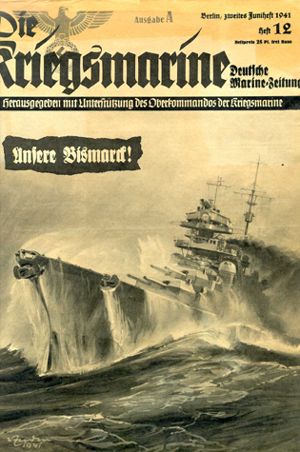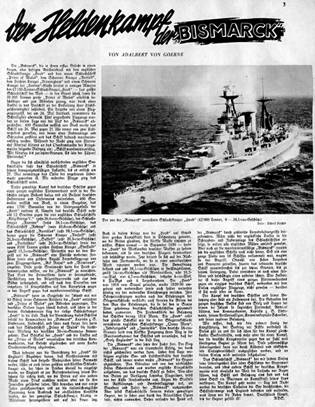
DIE KRIEGSMARINE
Deutsche Marine-Zeitung, June 1941
From: "Die Kriegsmarine", Deutsche Marine-Zeitung, an official journal published with the support of the Oberkommando der Kriegsmarine, Berlin , second issue for June 1941, issue 12, page 3. Editor-in-Chief: Korvettenkapitän Fritz Otto Busch. (From an original document in the collection of this archive).
 |

Front page of the journal Die Kriegsmarine - Deutsche Marine-Zeitung of June 1941 (left). Third Page (right).
|
The Heroic Fight of the BISMARCK
BY ADALBERT VON GOERNE
(translated into English by Ulrich Rudofsky and edited by George Elder)
The "Bismarck" was engaged in a short, but heavy artillery duel during her first battle with the English battlecruiser "Hood", the new battleship "Prince of Wales", the heavy cruiser "Norfolk", the light cruiser "Birmingham", and a "London" class heavy cruiser. In just a few minutes she [the masculine "he" was used within the German navy, editor] sent the 42,100 ton battleship "Hood" - largest battleship in the world - to the bottom. Furthermore, the 35,000 ton "Prince of Wales" was heavily damaged, and she was forced to withdraw. [Bismarck's] full speed was reduced by a hit in the forward section of the ship. A torpedo aircraft attack occurred on May 24th which reduced her speed further, [but] five attacking aircraft were shot down on that day by the "Bismarck's "anti-aircraft guns. On May 26th , 400 nautical miles west of Brest, the ship was hit again by two aerial torpedoes, one of which destroyed the rudder mechanism and propellers, and thus rendered the ship unable to maneuver. During the night, the following message from the Chief of the Fleet, Admiral Lütjens, was received by the Supreme Command of the Navy: "Ship has lost maneuverability. We fight until the last shell [is expended]. Long live the Fuehrer! Chief of the Fleet".
The battleship "Bismarck" fought in its immobilized condition against steadily reinforced English naval forces until she became the victim of overwhelmingly superior power on the forenoon of the 27th of May. The battleship sank with its flag flying.
This powerful fight by this [single] German ship (mounted) against an entire English Fleet formation will find a permanent place in history, and it will continue to live as a paradigm of German heroism and ultimate valor. Four hundred nautical miles west of Brest, in an area of the sea which is about 1700 nautical miles from the site of the sinking of the "Hood", the German battleship fought for more than 12 hours against four English battleships: the battleship "King George V" (ten 36.6 guns [35.6 cm, editor]), the battlecruiser "Renown" (six 38.1 cm guns), the battleship "Rodney" (nine 40.6 cm guns), the battleship "Ramillies" (eight 38.1 cm guns); furthermore, against the heavy cruisers "Norfolk" (eight 20.3 cm guns), "Suffolk" (eight 20.3 cm guns), "Dorsetshire" (eight 20.3 cm guns), as well as the new 9100 ton light cruiser "Sheffield" (twelve 15.2 cm guns). Moreover, the attack on the "Bismarck" included the deployment of a flotilla of modern destroyers as well as of fairly large number of torpedo aircraft from two aircraft carriers, the "Ark Royal" and "Victorious". Such a large force needed to be assembled by the enemy in order to destroy the "Bismarck". [In fact,] the entire main body of the home fleet had to be brought to bear, plus needed reinforcements that were drawn together from Atlantic patrols and [vessels stationed to] the South. Only after the arrival of 16 warships, did the enemy dare to launch an attack against the disabled (unmaneuverable) ship.
What does the destruction of the "Hood" mean to England? Not only has Great Britain lost her proudest symbol of sea power with this ship, but she has also lost her largest and most powerful battlecruiser. [The ship] was frequently deployed during peacetime wherever England thought it proper to maintain her image. Furthermore, the British used the vessel as a means of applying pressure on foreign powers or to protect their threatened interests. We need only look back a few years and consider the Abyssinian conflict, when the powerful battlecruiser lurked about the Mediterranean and lay in ready for ambush. In this war the "Hood" again made an appearance there (in the Mediterranean), when, based on the ship's great fighting strength, Britain felt it necessary to deploy her most powerful weapon. "Hood" already experienced the effectiveness of German arms once before - in September 1939 - when she was bombed and damaged by German aircraft. Now she was engaged in a return cruise from North America where she had been refitted in an American shipyard. The armament consisted of eight 38.1 cm guns in twin turrets, twelve 14 cm guns as middle artillery, eight 10.2 cm anti-aircraft guns, four 4.7 cm guns, sixteen 4 cm anti-aircraft guns, eight anti-aircraft machine guns, and six torpedo tubes. The "Hood" was launched in 1918, was rebuilt and modernized in 1929/1930, and was subsequently continuously upgraded with the most advanced equipment. Her armor protection was reinforced according to experience gained in the Battle of the Skagerrak. Furthermore, the British could evaluate the data gathered from the German battleships raised at Scapa Flow in their construction [plans]. The peacetime crew complement of the ship was 1314 men. The "Hood" was dealt the same fate as the English battlecruisers which were destroyed in the Battle of Skagerrak: "Queen May", "Indefatigable", and "Invincible". A German 38 cm shell penetrated into the ammunition chamber, despite the heaviest armor on the ship, and caused the "Pride of England" to blow sky-high.
However, "Bismarck" continued her cruise (despite being damaged). The "Bismarck's" victory was a triumphal success that no one can ever diminish. For more than three days, English sea- and air-forces pursued the German ship, and time and again the "Bismarck" knew how to shake off her opponents. From Gibraltar to the Northern-most harbors of Scotland, English warships were mobilized to search for and destroy the German ship. Squadrons of reconnaissance aircraft and bombers from every airbase at the disposal of British forces, even from the coast of Newfoundland, took off to determine the position, speed and direction of the "Bismarck". But even battleships could not daunt this formidable opponent (Bismarck) who plowed through the Atlantic Ocean. Therefore, the enemy first tried to bring "Bismarck" to grief through multiple torpedo air attacks. And had it not been for the unfortunate hit in the screws and rudder assemblies, all these English efforts would have been in vain. But even when the "Bismarck" was unable to maneuver, British ships still did not venture to attack. Only after a fleet of 16 vessels were assembled did they dare to mount an attack. Although hit by seven torpedoes and shells (prior to the final battle), the mortally wounded ship fired until its last shell was expended and it sank. During the course of these events it demolished a destroyer and seriously damaged another. Everyone clearly understands that the (British) attack was not a heroic deed, (and especially) since an entire fleet formation with the assistance of numerous aircraft went after a single German ship.
By contrast, the fight by the German ship and its crew exemplifies the deeds in a heroic epic. The hearts (thoughts) of the entire German Nation are filled with pride and grief for the Chief of the Fleet, Admiral Lütjens, the victor of the Battle of Island, for the Commanding Officer, Captain Lindemann, his Artillery Officer, Commander Schneider, and the valiant ship's crew.
We know that no other service branch is exposed to more risk during the conduct of war than those who fight on the high seas. This is more or less valid for battles between equally strong naval forces, but it is especially relevant when the German Navy has to routinely confront a superior enemy force. This numerical superiority can only be neutralized with bravery and unyielding devotion to duty, and this endeavor continues to persist!
The battleship "Bismarck's" actions have proven her superiority over every ship (of its) type presently known. Moreover, any other vessel in the German Navy will also show the world the fact that [our] ships and crews are united, and that each and every ship embodies a maximum of fighting power for its type. The battle continues - for day and night German units furrow through the oceans to threaten enemy sea-lanes and to sink any (enemy) ships that appear in their sights. Germany fights until the enemy is cut down!
Photo legend: Battlecruiser "Hood" destroyed by the "Bismarck" (42,000 tons, 8 -38.1 cm guns).
Back to: Printing Press | On-line Archive
|



